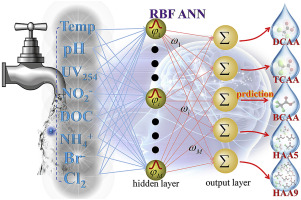当前位置:
X-MOL 学术
›
Chemosphere
›
论文详情
Our official English website, www.x-mol.net, welcomes your
feedback! (Note: you will need to create a separate account there.)
Radial basis function artificial neural network able to accurately predict disinfection by-product levels in tap water: Taking haloacetic acids as a case study.
Chemosphere ( IF 8.1 ) Pub Date : 2020-01-22 , DOI: 10.1016/j.chemosphere.2020.125999 Hongjun Lin 1 , Qunyun Dai 2 , Lili Zheng 1 , Huachang Hong 1 , Wenjing Deng 3 , Fuyong Wu 4
Chemosphere ( IF 8.1 ) Pub Date : 2020-01-22 , DOI: 10.1016/j.chemosphere.2020.125999 Hongjun Lin 1 , Qunyun Dai 2 , Lili Zheng 1 , Huachang Hong 1 , Wenjing Deng 3 , Fuyong Wu 4
Affiliation

|
Control of risks caused by disinfection by-products (DBPs) requires pre-knowledge of their levels in drinking water. In this study, a radial basis function (RBF) artificial neural network (ANN) was proposed to predict the concentrations of haloacetic acids (HAAs, one dominant class of DBPs) in actual distribution systems. To train and verify the RBF ANN, a total of 64 samples taken from a typical region (Jinhua region) in China were characterized in terms of water characteristics (dissolved organic carbon (DOC), ultraviolet absorbance at 254 nm (UVA254), NO2--N level, NH4+-N level, Br- and pH), temperature and the prevalent HAAs concentrations. Compared with multiple linear/log linear regression (MLR) models, predictions done by RBF ANNs showed rather higher regression coefficients and accuracies, indicating the high capability of RBF ANNs to depict complicated and non-linear relationships between HAAs formation and various factors. Meanwhile, it was found that, predictions of HAAs formation done by RBF ANNs were efficient and allowed to further improve the prediction accuracy. This is the first study to systematically explore feasibility of RBF ANNs in prediction of DBPs. Accurate predictions by RBF ANNs provided great potential application of DBPs monitoring in actual distribution system.
中文翻译:

径向基函数人工神经网络能够准确预测自来水中的消毒副产物水平:以卤代乙酸为例。
要控制由消毒副产物(DBP)引起的风险,需要预先了解其在饮用水中的含量。在这项研究中,提出了一个径向基函数(RBF)人工神经网络(ANN)来预测实际配电系统中卤代乙酸(HAAs,一种主要的DBPs)的浓度。为了训练和验证RBF神经网络,从水的典型特征(溶解的有机碳(DOC),254 nm的紫外线吸收率(UVA254),NO2- -N水平,NH4 + -N水平,Br-和pH),温度和常见的HAAs浓度。与多重线性/对数线性回归(MLR)模型相比,RBF神经网络所做的预测显示出较高的回归系数和准确性,表明RBF神经网络具有很高的能力,可以描述HAA形成与各种因素之间的复杂非线性关系。同时,发现通过RBF神经网络进行的HAAs形成的预测是有效的,并且可以进一步提高预测的准确性。这是首次系统地探索RBF神经网络在预测DBP中的可行性的研究。RBF神经网络的准确预测提供了DBP监视在实际配电系统中的巨大潜力。
更新日期:2020-01-22
中文翻译:

径向基函数人工神经网络能够准确预测自来水中的消毒副产物水平:以卤代乙酸为例。
要控制由消毒副产物(DBP)引起的风险,需要预先了解其在饮用水中的含量。在这项研究中,提出了一个径向基函数(RBF)人工神经网络(ANN)来预测实际配电系统中卤代乙酸(HAAs,一种主要的DBPs)的浓度。为了训练和验证RBF神经网络,从水的典型特征(溶解的有机碳(DOC),254 nm的紫外线吸收率(UVA254),NO2- -N水平,NH4 + -N水平,Br-和pH),温度和常见的HAAs浓度。与多重线性/对数线性回归(MLR)模型相比,RBF神经网络所做的预测显示出较高的回归系数和准确性,表明RBF神经网络具有很高的能力,可以描述HAA形成与各种因素之间的复杂非线性关系。同时,发现通过RBF神经网络进行的HAAs形成的预测是有效的,并且可以进一步提高预测的准确性。这是首次系统地探索RBF神经网络在预测DBP中的可行性的研究。RBF神经网络的准确预测提供了DBP监视在实际配电系统中的巨大潜力。











































 京公网安备 11010802027423号
京公网安备 11010802027423号